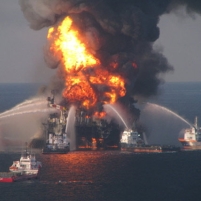National Engineering Academy Report on Gulf Oil Rig Explosion Blames Failure to Heed Warnings
Friday, November 19, 2010
 (photo: U.S. Coast Guard)
(photo: U.S. Coast Guard)
The warning signs were there, they just weren’t heeded. That is the conclusion of experts from the National Academy of Engineering who studied the possible causes of the Deepwater Horizon accident in the Gulf of Mexico.
The academy says there were “numerous technical and operational breakdowns” that contributed to the oil rig explosion and spill, indicating the parties involved did not have a reliable system in place for “managing the inherent risks, uncertainties, and dangers associated with deepwater drilling operations.” There also was a failure to learn from previous “near misses,” and “insufficient checks and balances” for ensuring well safety when preparing it to go into production.
“Important decisions made to proceed toward well abandonment [sealing the well during transition to production] despite several indications of potential hazard suggest an insufficient consideration of risks,” said Donald Winter, former secretary of the Navy, professor of engineering practice at the University of Michigan, and chair of the study committee. “It’s also important to note that these flawed decisions were not identified or corrected by BP and its service contractors, or by the oversight process employed by the U.S. Minerals Management Service and other regulatory agencies.”
Evidence shows that the cementing performed around the well was not “an effective barrier to prevent gases from entering the well;” it was a gas leak that caused the explosions that destroyed the rig.
The experts added that it may impossible to “definitively establish” the precise reason behind the blowout and explosion, due to the loss of the oil platform and important records, as well as the 11 workers who died witnessing the accident as it unfolded.
-Noel Brinkerhoff
Events Preceding Deepwater Horizon Explosion and Oil Spill Point to Failure to Account for Safety Risks and Potential Dangers (National Academy of Engineering)
Interim Report on Causes of the Deepwater Horizon Oil Rig Blowout and Ways to Prevent Such Events (National Academy of Engineering)
- Top Stories
- Unusual News
- Where is the Money Going?
- Controversies
- U.S. and the World
- Appointments and Resignations
- Latest News
- Trump to Stop Deportations If…
- Trump Denounces World Series
- What If China Invaded the United States?
- Donald Trump Has a Mental Health Problem and It Has a Name
- Trump Goes on Renaming Frenzy






Comments